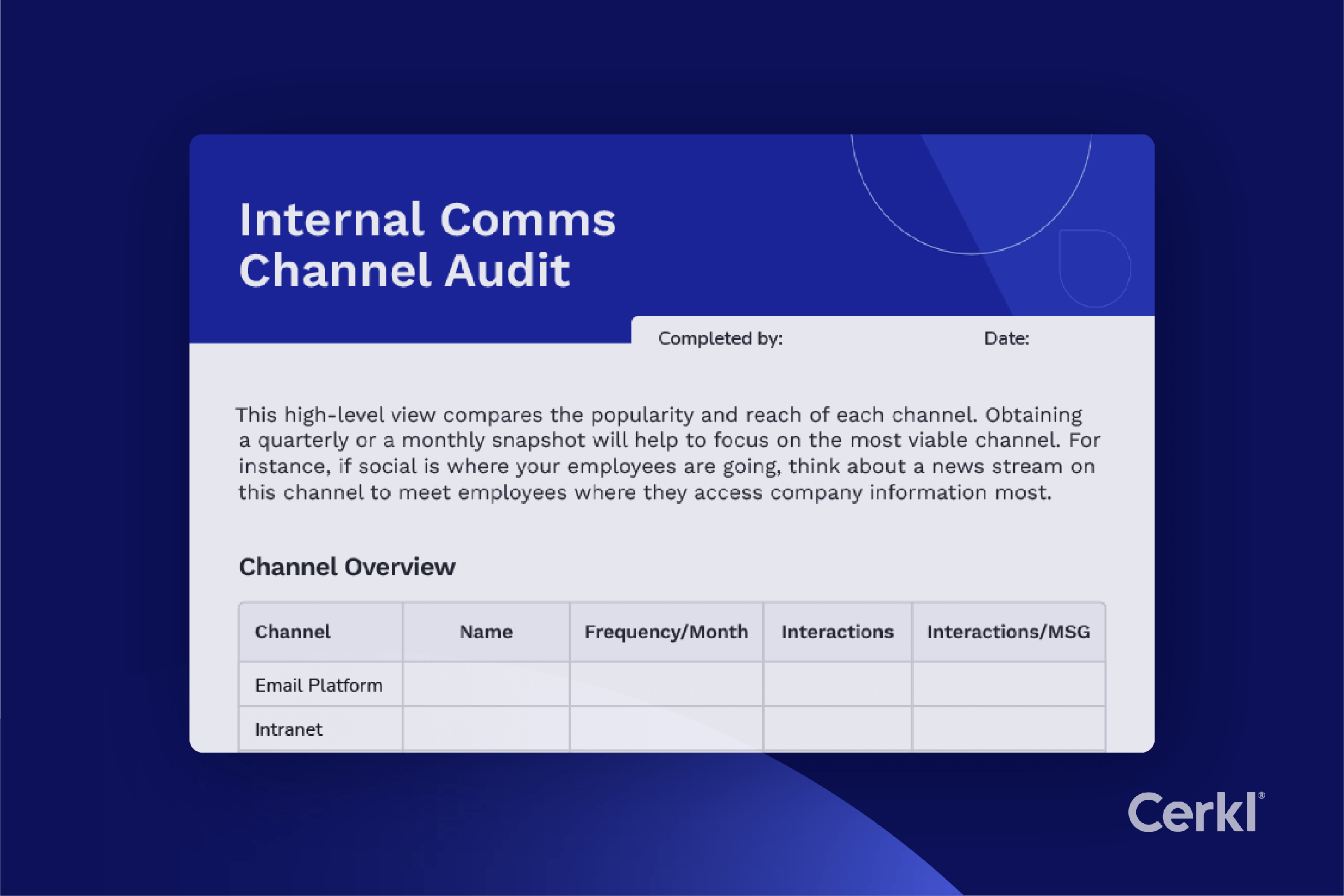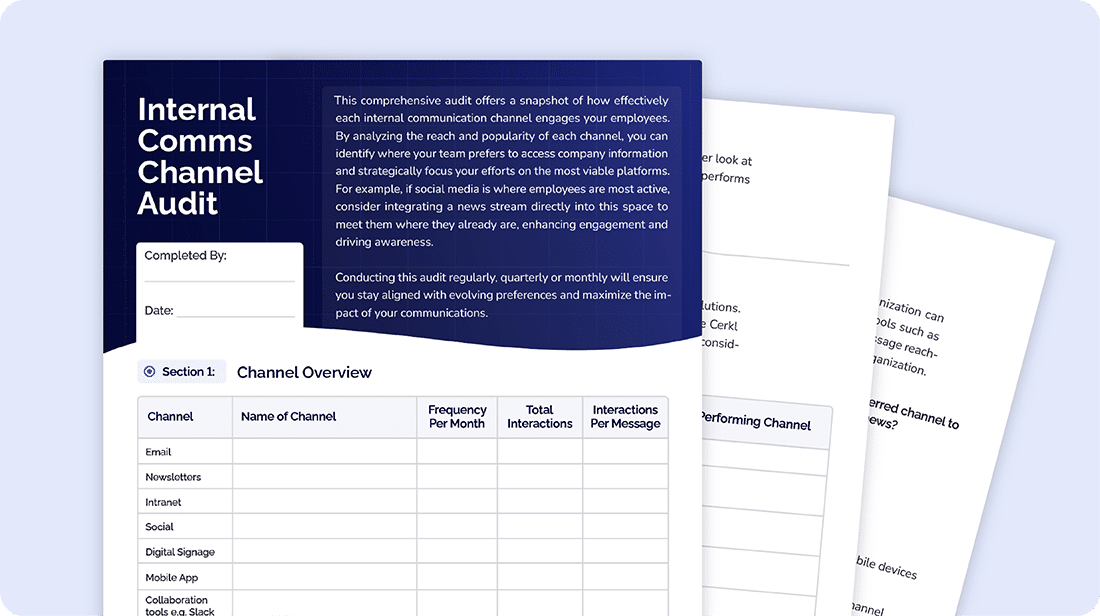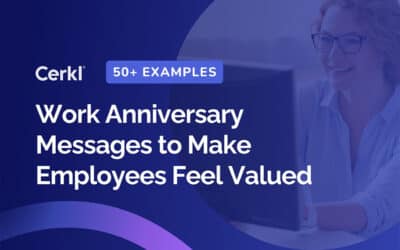Promoted largely by the increase in remote work and hybrid opportunities, the concept of omnichannel employee communication is a great marketing strategy originally developed for effective interaction with customers.
While the employee experience (EX) is relatively new, and constantly evolving, its central theme is the same as the more established customer experience (CX).
Table of contents
- What is Omnichannel Communication?
- What is an Omnichannel Employee Experience?
- Empowering Engagement by Redefining Communication
- Link Between the Omnichannel EX and Omnichannel CX
- Benefits of an Omnichannel Employee Experience
- How to Build a Successful Omnichannel Employee Experience
- Best Practices of Omnichannel Communication
- Case Study: Gulfstream Aerospace Embarks on a New Communication Strategy
- Leveraging an Omnichannel Communication Platform
- Embracing the Future of Connectivity
- What’s Next
- FAQ
As head of Customer Success at Cerkl, Maddy Rieman has deep insights into CX. Furthermore, her constant liaison with customers has made her acutely aware of the value of working with a communication platform with a powerful omnichannel capability. “Creating a positive, unified employee experience across all your communication channels leads to more engaged, productive, and satisfied employees,” she says.
Unsurprisingly, she identified building an omnichannel employee experience as one of the Top 10 internal communication challenges during our workshop at the 11th Annual Strategic Internal Communications — West Conference in San Francisco.
We’re going to talk about what this is, what it means, and how best to embrace the challenges of creating a positive omnichannel employee experience. But first, let’s start with a basic discussion about omnichannel communication.
What is Omnichannel Communication?
Omnichannel communication refers to a seamless, integrated approach where communicators interact with employees across various channels. These include Sharepoint, email, mobile apps, and Slack. These channels provide consistent and personalized experiences. This strategy aims to enhance engagement and satisfaction by maintaining a unified presence across all touchpoints. The process reduces “noise” for employees and empowers them to use whichever channel they prefer.
As an example, in the healthcare industry, there are many desk-based and deskless employees. Reaching every employee through email is virtually impossible and not reasonable to expect. This is why healthcare communicators use omnichannel communication to ensure open enrollment information reaches every employee, regardless of their desk status. Some employees read the content on Cerkl Broadcast’s mobile app, some through Microsoft Teams, and some via email. Every employee uses their preferred channel to receive information, ensuring important information is communicated throughout the entire organization.
Organizations that implement an omnichannel communication strategy do so because it is a comprehensive approach that integrates various communication channels, creating an omnichannel communication platform. Omnichannel communication focuses on seamless transitions between channels. If it is used within the organization, it enables employees to engage effortlessly while maintaining a cohesive brand presence. Data from each touchpoint is utilized to tailor interactions and improve employee satisfaction and engagement throughout their journey.
Ultimately, this becomes a positive omnichannel employee experience.
What is an Omnichannel Employee Experience?
Imagine work interactions that flow seamlessly, no matter where or how you work. That’s the essence of an omnichannel employee experience. It ditches the siloed approach, where information gets lost between email, intranet, and other channels.
Instead, an omnichannel EX unifies these channels. Employees can access company resources, get support, and stay informed through their preferred channels, be it a mobile app, a social collaboration platform, or even an in-person meeting. The key is consistency. The experience feels the same, positive, and helpful regardless of the touchpoint.
This integrated approach empowers employees. They can find what they need quickly, collaborate effectively, and feel valued. It fosters a sense of belonging and purpose, ultimately leading to a more engaged and productive workforce.
But, the concept of omnichannel communication goes beyond mere communication. It’s about providing a holistic experience that goes beyond physical boundaries. Through using advanced technology, organizations can create an environment where both desked and deskless employees can access the same information, resources, and opportunities with ease. This concept of unity is the heart of omni-communications — the idea that every member of the team is on the same page, contributing to a shared vision.
Empowering Engagement by Redefining Communication
A remarkable outcome of embracing omnichannel communication is the reduction of message overload. This includes traditional email, instant messages, video conferences, and phone calls. According to a 2023 online survey from Loom, U.S. employees are spending so much time communicating about work, they’re struggling to get their work done. Their survey report, Mind The Communication Gap, shows how communication overload is literally derailing productivity in the workplace. While 35% of employees are losing time because of constant interruptions, 85% send the same messages or information multiple times, often to multiple places every week. And 69% of them do this daily.
The solution is omnichannel comms. By transitioning to interactive channels including targeted emails, people can access their communications on their preferred platform. The omnichannel experience is about meeting your employees where they are. When people are more engaged with their job, they will engage more with their communications.
The advantage lies in the consistent and personalized experience delivered across all touchpoints. It enables people to use their favorite channels without losing context. This not only fosters convenience but also builds stronger relationships as they feel understood and valued.
Cerkl’s omnichannel capability allows all channels to communicate with each other. When an employee views something in one channel, it is removed from the other channels. So when they check other channels, they see new but relevant material. This reduces “noise” for the employees and allows them to engage with more content.
Employees, accustomed to user-friendly interfaces outside the workplace, naturally gravitate towards omni-communications tools that mirror themselves. If they have communication channels that they engage with more and prefer, then they will have a better workplace experience.
Link Between the Omnichannel EX and Omnichannel CX
Companies have been focusing on providing a seamless customer journey across multiple touchpoints (phone, email, social media, and so on) for quite some time. The term omnichannel CX gained traction in the early 2010s as technology facilitated a more interconnected approach.
While employee satisfaction has always been important, the concept of a holistic EX strategy is a more recent development. The rise of remote work, the importance of employer branding, and advancements in communication and collaboration tools have all contributed to a growing focus on EX in recent years.
It stands to reason that the benefits of omnichannel communications for both are closely related. Happy and empowered employees lead to better customer service. So, while the specific focus on omnichannel EX might be newer, it builds upon the existing understanding of CX.
Tim Vaughn, editorial director of Poppulo, wrote a white paper, The Multi-Million Dollar Impact of Communication on Employee & Customer Experience. In it, he states that 90% of organizations see EX as a priority. Furthermore, most of the executives they surveyed (58%) said providing an excellent EX translates to employees providing customers with an excellent experience.
“There is an increasing realization that employee experience, workplace experience, and customer experience are completely interlinked and interdependent. And communication is the oil that ensures all moving parts work smoothly together for the benefit of the company, its people, and its customers.”
Tim Vaughn
Cerkl Broadcast is, of course, a highly successful omnichannel communications platform. We know that a major challenge in modern workplace communication is tailoring messages to resonate with different employee groups, while keeping communication clear and avoiding excessive messages. Omnichannel communication can be a powerful tool to achieve this balance by allowing for targeted messaging through various channels.
The Cerkl Broadcast Difference
For Cerkl Broadcast, mass personalization is a core principle and the main method internal communicators use to ensure EX has maximum impact. We use mass personalization via our newsletter digests that are built en-mass and hyper-personalized across channels, based on how employees engage with various issues.
Benefits of an Omnichannel Employee Experience
A successful internal communications strategy empowers employees. For this reason, it’s important to build it around their needs. Maddy advises companies to craft communication that prioritizes employee’s needs. She also emphasizes the advantages of delivering communications on their preferred channels (mobile, desktop, and so on) with personalized, relevant information. This fosters a sense of purpose, belonging, and strengthens company culture.
Ultimately, here are five key benefits of a successful strategy.
Boosted Productivity
Employees can access the information and resources they need quickly and easily, on their preferred channels. This eliminates time wasted searching through emails or outdated intranets, allowing them to focus on getting things done.
Happy and Engaged Employees
When employees feel supported and empowered by a seamless EX, they’re more likely to be satisfied and engaged in their work. This translates to a more positive work environment and lower turnover rates.
Improved Communication and Collaboration
An omnichannel approach breaks down communication silos. Employees can collaborate effectively across departments and locations, fostering a more connected and dynamic work culture.
Stronger Employer Branding
In today’s competitive talent market, a positive EX can be a key differentiator. By prioritizing your employees’ needs and providing a smooth experience, you can attract and retain top performers.
Data-Driven Decision Making
Omnichannel platforms allow you to track employee interactions and preferences. This valuable data can be used to refine your communication strategies and tailor content to better meet employee needs.
How to Build a Successful Omnichannel Employee Experience
The first step, says Maddy, is to get IT to pull data that shows employee numbers in terms of their generation. This will enable you to segment your audience for communication. From oldest to youngest, she identifies:
- Silent 1928-1945
- Baby Boomer 1946-1964
- Gen X 1965-1980
- Millennial 1981-1996
- Gen Z 1997-2015
Then ensure that major campaigns are created with sufficient variety in the media you use to attract the different generations in your workforce. For example, long form text vs short video clips. Never forget about employee engagement.
You also need to be sure that you get to your employees in the best way possible.
“You need to meet employees where they are,” says Maddy. This means finding out what tools and systems employees spend most of their time working in. You also need to ascertain how you can utilize those platforms to disseminate communications.
“Requiring that employees go to the ‘employee intranet’ to find that one page for the content they are looking for, will reduce the likelihood of them taking that CTA.”
Best Practices of Omnichannel Communication
The best practices for building a successful omnichannel communication strategy range from identifying your audience to utilizing the best possible technologies.
Know Your Audience
We’ve mentioned the importance of segmenting your employee audience in terms of generation. Another reason relates to the different needs and preferences of your employees. You need to understand these so that you can tailor content and communication styles to different groups including remote workers, managers, and new hires.
It is also vital to continuously solicit employee input through surveys and focus groups to ensure your omnichannel approach is meeting their needs.
Craft a Unified Experience
Crafting a unified experience requires a seamless flow of information. Ensure consistent messaging and information across all communication channels including email, mobile apps, and intranet.
Personalized content is vital. So, be sure to deliver targeted information relevant to each employee group’s needs and interests.
Prioritize Accessibility and Convenience
You need to implement a mobile-friendly approach. Make information and resources readily available on mobile devices for on-the-go access.
Self-service options can also be amazingly useful. Empower employees with easily accessible knowledge bases, FAQs, and self-service tools to find answers themselves. You don’t have to feed them all the info.
Omnichannel support is even more important. For this reason, offer consistent and helpful support across all communication channels, with clear escalation paths if needed.
Technology is Key
Integrated systems will ensure all your communication and resource platforms work together seamlessly. Data should flow freely to avoid silos and ensure a smooth user experience.
Automation will enable you to leverage automation tools to streamline repetitive tasks like sending notifications or scheduling updates. Marketing automation tools streamline repetitive tasks like email marketing, campaign management, lead scoring and social media posting. Automated workflows can also simplify tasks like data backup and file organization. The options are endless.
Don’t Forget the Human Touch
While automation is helpful, prioritize genuine human interaction, especially for complex issues or employee onboarding.
Also, continuously gather employee feedback to improve the omnichannel experience. This demonstrates that you value their input and fosters a sense of community.
By following these best practices, you can create a unified and positive communication experience for your employees across all channels. This will lead to a more engaged, productive, and satisfied workforce.
What Channels Do We Use for an Omnichannel Strategy?
Of course, the channels you use for a good omnichannel strategy that will result in the best omnichannel employee experience depend on your business needs. They include traditional channels like email, digital channels including mobile apps, and other so-called self-service channels employees can employ.
Traditional Channels
- Emails are a tried-and-true channel for important announcements, company news, and targeted content.
- The intranet is a centralized location for housing company policies, resources, and documents.
- Company meetings allow for regular in-person or virtual meetings to foster communication and a sense of community.
Digital Channels
- Mobile apps provide a convenient way to deliver personalized content, notifications, and on-the-go access to resources.
- Social collaboration platforms like Slack or Microsoft Teams can facilitate communication, collaboration, and knowledge sharing very effectively.
- Internal social media platforms enable employees to connect, share ideas, and build relationships.
- Video conferencing enables real-time communication and collaboration regardless of location.
Self-Service Channels
- A reputable knowledge base provides a searchable repository of answers to frequently asked questions and troubleshooting guides.
- Internal wikis allow employees to collaboratively create and share knowledge and best practices.
- Chatbots or virtual assistants can answer basic questions, provide support, and automate tasks.
But as Maddy cautions, it’s not about using every single channel. The key is to choose a variety of channels that cater to your employees’ preferences and ensure a consistent and positive experience across all touchpoints.
Case Study: Gulfstream Aerospace Embarks on a New Communication Strategy
In 2023, Cerkl CEO Tarek Kamil spoke at a conference with Anthony Bolton, Senior Manager of Employee Communications, Events and Brand at Gulfstream Aerospace. Anthony has had the unique challenge of building and executing a strategic communications plan for an aircraft manufacturing company of nearly 20,000 employees, the vast majority of whom are deskless. Reaching an audience with that makeup may seem daunting. After all, it’s hard enough to reach desk-based employees, but even more difficult to reach deskless workers. While digital communications help in this task, it’s not the end all be all. It takes a bit more finesse and intentionality to reach both desked and deskless employees.
So, how did they accomplish this achievement?
They set out to achieve a lofty goal of allowing all employees, no matter what their hierarchy in the organization, the ability to “stay informed, anytime, anywhere.” With lots of backing from leadership, Anthony and his team of innovative communicators deployed Cerkl Broadcast’s My News. This is a feature that personalizes content for every employee at any location – with or without a desk. It uses an omnichannel communications approach, so employees aren’t seeing the same content when they open up various channels of communication. By sending this to all the channels of communication they could access, it also maximized the reach of employees who may not have had email.
This shows that a mobile app is a great way to reach deskless employees. The lesson is that when deskless or remote employees check their email, new relevant content will be there rather than the content they have already viewed on the employee communication app. This is what the omnichannel employee experience is all about.
The Importance of Socialization in Gulfstream’s Omnichannel Success
Tarek Kamil adds that another important component of their communication and engagement success is how they socialized the new communication strategy.
”They did an excellent job of communicating how their ‘new modern communications experience’ would improve the lives of their employees and why it is important. When employees understand the goals and strategy of leadership, they are more likely to adopt new practices. Socialization is an important part of successful implementation of new communication strategies.
To that end, they used a variety of socialization strategies to encourage mobile app adoption such as printed materials, booths at employee engagement events, giveaways, and more. This has led to a 200% increase in adoption in just the past 6 months.”
Tarek Kamil
It certainly is a success story of note!
Leveraging an Omnichannel Communication Platform
Addressing the challenge of reaching hard-to-engage employees is essential in the remote and hybrid workforce. Omni-communications offers an excellent solution. With the power of an omnichannel communication platform, organizations can tap into alternative strategies. Mobile apps, internal social networks, and push notifications create a web of connectivity, ensuring that every employee — regardless of their location or the channels available to them — feels included and informed.
Maddy advises every business to unclog employee inboxes. “Not everything has to be a direct email, every single time.”
Ultimately, the key to effective omnichannel communication lies in the strategic implementation of an omnichannel communication platform. This platform seamlessly integrates diverse communication channels, transforming them into one ecosystem that works for everyone. More importantly, it ensures that every employee is part of the conversation, eradicating silos and boosting collaboration and enabling an omnichannel employee experience.
To successfully implement and harness the power of omnichannel communications, businesses must adopt a well-rounded approach. It should prioritize seamless communications and engagement. Understanding user preferences, behaviors, and channel usage patterns lays the foundation for effective implementation. Selecting relevant communication channels based on this analysis ensures that resources are invested where they matter most.
Ensuring content consistency across channels, along with personalized messaging, builds familiarity and trust within omni-communications. Implementing tools for cross-channel continuity, real-time responsiveness, and efficient query resolution guarantees a smooth and positive experience. Regularly monitoring analytics and seeking customer feedback enables refinement of the strategy, ultimately driving enhanced engagement and loyalty.
However, there is a caveat. Maddy warns that organizations should see channel adoption as additive to their communications strategies.
“Don’t expect that your employee mobile app will receive 100% adoption. Reframe that thinking. Ask yourself, How many of the mobile app adopters have frequent visits/sessions? This is a better metric of success for any given channel.”
Embracing the Future of Connectivity
Omnichannel communication is an approach that has the potential to transform organizational dynamics. At its core, it’s about unity — the unison of desked and deskless employees, brought together by a shared omnichannel communication platform. It connects all workers no matter where they work or what communication channels they prefer and ultimately improves the omnichannel employee experience.
Embrace the power of omni-communications and shape an environment where every employee’s voice is heard, and every role contributes to your organization’s success.
What’s Next
Are you ready to experience the transformative potential of omnichannel communication?
The first step is to examine your existing internal communications strategy to see what you can do to improve it. You can do this on your own right now with our free internal communications audit.
FAQ
An omnichannel employee experience involves giving employees a unified and positive experience across all company communication channels, from email and intranet to mobile apps.
Yes, segmenting your audience is crucial. Tailoring content and communication styles to different employee groups (remote workers, managers, new hires) ensures everyone gets the information they need in a way that resonates with them personally.
All employees benefit! From deskless workers who need info on-the-go to managers who rely on collaboration tools, an omnichannel experience empowers everyone to be productive and engaged.
While both aim for seamless experiences, an omnichannel customer experience focuses on a customer’s journey across different touchpoints (website, social media, stores). An omnichannel employee experience focuses on an employee’s journey within the company using various internal channels.







